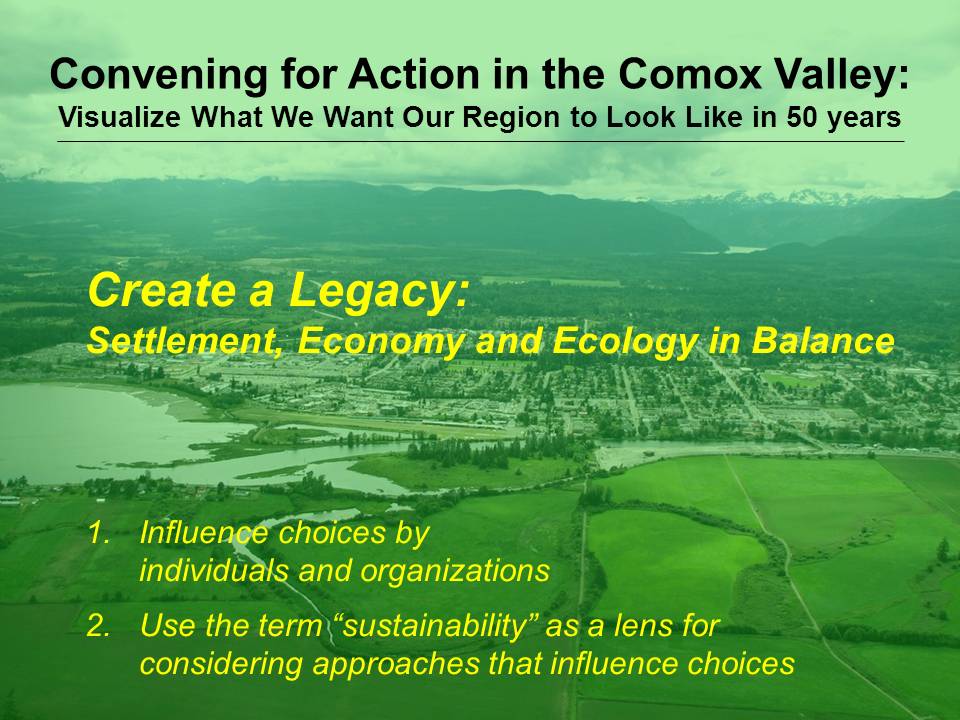Rainwater Management in the Comox Valley Regional District Electoral Areas: Current Practice and Future Options
Note to Reader:
The Comox Valley Regional District (CVRD) is one of four local governments that comprise the CAVI-Comox Valley Regional Team, where CAVI is the acronym for Convening for Action on Vancouver Island. The Comox Valley is the fourth largest regional district on Vancouver Island with a population approaching 65,000.
During the period 2007-2011, the Comox Valley regional team hosted annual seminar series and/or events that were open to all. In 2012, however, the process was an internal one. This resulted from a commitment by all jurisdictions to move from talk (awareness) to action (practice) in addressing Rainwater Management in a Watershed Sustainability Context. Meetings were conducted as ‘working sessions’, and were outcome-oriented.
In March 2013, the CVRD released a technical and legal review titled Rainwater Management in the Comox Valley Regional District Electoral Areas: Current Practice and Future Options. The article below is organized in three parts: 1) context for regional action in commissioning the report; 2) an introduction to the emerging watershed-based approach; and 3) a synopsis of provincial requirements for drainage in electoral areas.
Rainwater Management in a Watershed Sustainability Context
In August 2011, the Comox Valley Regional Board passed a series of resolutions pertaining to an integrated watershed approach to rainwater management. These resolutions highlighted the need for province-wide action related to how drainage is regulated by the Ministry of Transportation and Infrastructure (MoTI) in electoral areas within regional districts.
Overview of Responsibilities in Electoral Areas
In British Columbia, the term ‘local government’ encompasses municipalities and regional districts. The distinction is significant. Municipalities have extensive and very specific regulatory tools to achieve watershed-based goals and objectives, yet regional districts do not. Regional districts do have enabling powers, however, to establish a drainage function within a service area boundary.
 “The Ministry is responsible for managing stormwater and drainage outside of municipal boundaries through the construction and maintenance of the provincial road network. Much of the drainage and infrastructure related to stormwater is studied, designed and constructed through the subdivision process controlled by the MoTI. The Comox Valley Regional District (CVRD) does play an advisory role as part of the subdivision referral process through the provincial approving officer,” explained Debra Oakman, the CVRD’s Chief Administrative Offer, in her report to the Board.
“The Ministry is responsible for managing stormwater and drainage outside of municipal boundaries through the construction and maintenance of the provincial road network. Much of the drainage and infrastructure related to stormwater is studied, designed and constructed through the subdivision process controlled by the MoTI. The Comox Valley Regional District (CVRD) does play an advisory role as part of the subdivision referral process through the provincial approving officer,” explained Debra Oakman, the CVRD’s Chief Administrative Offer, in her report to the Board.
“CVRD does have responsibility to ensure proper stormwater and drainage management when land alteration occurs as a result of development that was enabled by the CVRD, typically through a rezoning or development permit process.”
To Learn More:
To download a copy of the August 2011 Staff Report on Electoral Area Stormwater and Drainage Management, click here.
Regional districts are a unique feature of the British Columbia local government system which date back to the early 1960’s. In the absence of municipalities, regional districts are the “local” government for rural areas. To download an explanatory document, click on A Primer on Regionad Districts in British Columbia.
Current Practice and Future Options for Watershed-Based Rainwater Management in the Comox Valley
“The Ministry of Transportation and Infrastructure has historically had primary responsibility for managing rainwater and drainage outside municipal boundaries. However, residents in electoral areas affected by an increasing number of drainage problems are looking to the regional district to take the lead with a watershed-based approach to rainwater management,” explains Kevin Lorette, General Manager of the CVRD’s Property Services Branch.
“Recog nizing the importance of the issue, the Regional Board identified a rainwater strategy as a NOW priority in its September 2012 Strategic Plan. An action item was a legal and technical review of current practices and future options. This work has been completed, recommendations were approved by the Board in March 2013, and implementation of first steps is proceeding.”
nizing the importance of the issue, the Regional Board identified a rainwater strategy as a NOW priority in its September 2012 Strategic Plan. An action item was a legal and technical review of current practices and future options. This work has been completed, recommendations were approved by the Board in March 2013, and implementation of first steps is proceeding.”
Regional Team Approach
“The Comox Valley Regional District has worked closely with the Ministry, City of Courtenay, Town of Comox and Village of Cumberland to develop an understanding of the legislative framework for managing rainwater in the Comox Valley. Our collaboration is founded on a ‘regional team approach’ that aligns efforts and recognizes that nature has no borders.”
“Rainwater management policy statements and development permit area guidelines will be developed; will include objectives to address climate change impacts, adaptive management and performance standards; and will be implemented as part of the current Official Community Plan review. A report on the resource requirements and next steps for implementing a rainwater management strategy for the Comox Valley Regional District Electoral Areas will be prepared as the next step in this process.”
“In order to manage rainwater and drainage according to best practices, an integrated, basin-wide approach is needed. This will involve close collaboration between the CVRD and member municipalities as well as MoTI, and large private land owners such as forestry companies. The Comox Valley regional CAVI team includes these members and has been meeting regularly over the past four years to discuss these issues,” wrote Kevin Lorette in the staff report to the Regional Board.
To Learn More:
To download a copy of the March 2013 Staff Report on Rainwater Management – Legal and Technical Review, click here.
Also, click on Rainwater Management in the Comox Valley Regional District Electoral Areas: Current Practice and Future Options to download a copy of the supporting report.
Ministry Requirements for Drainage Design in Electoral Areas
In May 2011, the second in the annual Comox Valley Seminar Series addressed urban watershed protection and restoration issues. The focus of Seminar #2 was on a ‘design with nature’ approach to green infrastructure that integrates rainwater management and drought management. The discussion regarding alignment of efforts at a watershed scale resulted in posting of an article on waterbucket.ca that dealt with the role of the Ministry of Transportation and Infrastructure as the approving authority for land development in general, and drainage design in particular, in electoral areas within regional districts.
Alignment with Municipal Rainwater Management
“The Ministry of Transportation and Infrastructure has adopted drainage requirements for land development that are aligned with the desired outcomes for the Province’s Living Water Smart and Green Communities initiatives. Both are about adaptation to a changing climate. Both encourage shared responsibility,” reports Kim Stephens, Executive Director of the Partnership for Water Sustainability in BC.
“ In June 2007, the Ministry released the BC Supplement to TAC Geometric Design Guide 2007 Edition. From a local government perspective, Chapter 10 is the key. It outlines the requirements for drainage designs. Of paramount significance, Chapter 10 makes a distinction between highway drainage design and land development drainage design. This distinction provides the Ministry with the capability to align its efforts with municipalities and support a consistent watershed-based approach to rainwater management.”
In June 2007, the Ministry released the BC Supplement to TAC Geometric Design Guide 2007 Edition. From a local government perspective, Chapter 10 is the key. It outlines the requirements for drainage designs. Of paramount significance, Chapter 10 makes a distinction between highway drainage design and land development drainage design. This distinction provides the Ministry with the capability to align its efforts with municipalities and support a consistent watershed-based approach to rainwater management.”
“The BC Supplement references both Stormwater Planning: A Guidebook for British Columbia and the Water Balance Model for British Columbia. These provide the policy and technical foundation for contemporary rainwater management in BC. This foundation is keyed to an understanding of the integrated strategy for managing the rainfall spectrum (refer to image above), ranging from light showers to extreme storms.”
“Released in 2002, the Guidebook was a catalyst for action to implement a ‘design with nature’ approach to rainwater management and green infrastructure. The Water Balance Model was developed as an extension of the Guidebook.”
Beyond the Guidebook: Protect Stream Health
“In June 2007, Beyond the Guidebook: Context for Rainwater Management and Green Infrastructure in British Columbia was released. By then, practitioners were becoming comfortable with what ‘rainfall capture’ meant in practice. So, it was time to focus attention on how to truly protect and/or restore stream health in urban watersheds,” continues Kim Stephens.
“Beyond the Guidebook initiated the paradigm-shift from the single-function view of traditional ‘stormwater management’ to the integrated and holistic perspective that is captured by the term ‘RAINwater Management’. This also set the stage for defining water sustainability as an outcome` of green infrastructure policies and practices.”
“Stream health protection is a driver for Beyond the Guidebook. Stream health is a function of flow duration, and therefore correlates with stream erosion. Flow duration is something that we can measure and verify. We can also assess the potential for erosion or sediment accumulation within a watershed.”
“Released in June 2010, Beyond the Guidebook 2010: Implementing a New Culture for Urban Watershed Protection and Restoration in British Columbia provides guidance for aligning local actions with provincial and regional goals to ‘design with nature’ so that British Columbians can create greener communities, live water smart and prepare for climate change,” states Kim Stephens.
“On this matter of alignment, the language in Chapter 10 of the Ministry’s BC Supplement mirrors the objectives in Beyond the Guidebook 2010. In particular, Chapter 10 states that flows must be managed to ensure that no increase in flooding and stream erosion occur as a result of development storm drainage.”
To Learn More:
To download a copy of the complete Chapter 10, click here. The relevant information is contained on the second and third pages in the sub-sections titled Discharge Rates for Land Development and Detention Storage and Run-off Controls, respectively.




